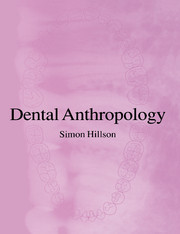Book contents
- Frontmatter
- Contents
- Acknowledgements
- Abbreviations
- 1 Introduction to dental anthropology
- 2 Dental anatomy
- 3 Variation in size and shape of teeth
- 4 Occlusion
- 5 Sequence and timing of dental growth
- 6 Dental enamel
- 7 Dentine
- 8 Dental cement
- 9 Histological methods of age determination
- 10 Biochemistry of dental tissues
- 11 Tooth wear and modification
- 12 Dental disease
- 13 Conclusion: current state, challenges and future developments in dental anthropology
- Appendix A: Field and laboratory methods
- Appendix B: Microscopy
- References
- Index
Appendix A: Field and laboratory methods
Published online by Cambridge University Press: 05 June 2012
- Frontmatter
- Contents
- Acknowledgements
- Abbreviations
- 1 Introduction to dental anthropology
- 2 Dental anatomy
- 3 Variation in size and shape of teeth
- 4 Occlusion
- 5 Sequence and timing of dental growth
- 6 Dental enamel
- 7 Dentine
- 8 Dental cement
- 9 Histological methods of age determination
- 10 Biochemistry of dental tissues
- 11 Tooth wear and modification
- 12 Dental disease
- 13 Conclusion: current state, challenges and future developments in dental anthropology
- Appendix A: Field and laboratory methods
- Appendix B: Microscopy
- References
- Index
Summary
Excavation of skulls, jaws and dentitions
Further reading
Spriggs & Van Byeren (1984), Watkinson (1978) and Koob (1984).
Excavation
Excavators should be familiar with both adult and young children's remains (see the sequence in Figure 5.9), and the spoil should be sieved through a 5 mm mesh, to catch small fragments. Ancient bone is often soft, and must not be scraped or brushed vigorously, so it is better to pick away the burial matrix gently. The remains should be recorded and removed rapidly, and shielded from hot sun to prevent them from drying out too fast.
If the remains are tough enough to lift immediately, they are exposed, lifted out and bagged up (the skull and dentition are best bagged together, checking that all the expected teeth are included).
If the remains are too fragile they need to be lifted in their block of burial matrix. A heavy gauge (0.5 mm thick) aluminium foil wrapping may provide sufficient support, but loose burial matrix may need further support. The block may be encapsulated in plaster bandages, after first wrapping with plastic film or aluminium foil, or supported by injecting consolidant emulsion (5–10% weight/volume concentration, page 297) into a series of holes, prodded into the matrix well away from bones and teeth.
Samples for biochemical analysis should be taken at the time of lifting, using clean gloves and tools, together with sterile sample pots (some have a spatula built into the lid, which avoids any hand contact).
- Type
- Chapter
- Information
- Dental Anthropology , pp. 295 - 308Publisher: Cambridge University PressPrint publication year: 1996



